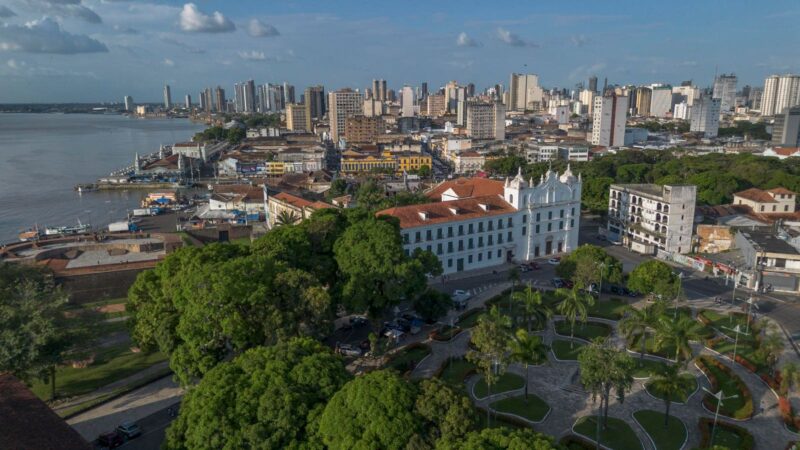The city of Belém in Brazil will host the COP30 climate conference in November, 2025.
getty
As the world prepares for the UN’s COP30 climate change conference in Brazil this November, global climate diplomacy faces a defining test.
Ten years after the Paris Agreement, the latest Production Gap Report from the Stockholm Environment Institute and UNEP delivers a sobering verdict: governments are planning to produce far more fossil fuels than climate targets allow.
As the report warns, “Governments are collectively planning to produce more than double the amount of fossil fuels in 2030 than would be consistent with limiting warming to 1.5ºC.”
This paradox is now the defining challenge of international climate politics. Leaders make bold pledges to cut emissions, yet fossil fuel production plans continue to expand. The result is a widening gap between rhetoric and reality, with every year of delay making the 1.5ºC goal harder and costlier to achieve.
Few Targets, Weakened Signals
One of the most concerning signals ahead of COP30 is the lack of updated nationally determined contributions (NDCs). These targets are the backbone of the Paris Agreement, outlining each country’s pathway to reduce emissions.
Yet only a handful of countries have submitted new or more ambitious pledges. With less than two months to go, the silence from most major producers raises questions about political will and about what level of ambition negotiators will bring to Brazil.
At the same time, Europe’s climate voice has weakened. Political shifts, high energy prices, and competing priorities among them defense have tempered the EU’s dominant leadership on climate policy.
The bloc is now debating its 2035 emissions target, expected to fall between 66% and 72% below 1990 levels. A linear pathway between the 55% cut targeted for 2030 and the 90% reduction proposed for 2040 would align with the upper end of that range.
But the next phase of reductions will be far tougher to achieve. Cutting emissions beyond 75% means tackling the really hard-to-abate sectors within heavy industry, agriculture, air transport and deep sea shipping, where technological and economic barriers remain very high.
Norway, too, exemplifies the paradox. It is a world leader in renewable deployment and electric mobility, yet continues to plan new oil and gas developments for export. Mixed signals from regions that once drove climate ambition risk undermining momentum at a crucial juncture.
A Global Pattern
Brazil, host of COP30, has made remarkable progress on renewables with over 80% of its electricity from clean sources and reaching its 2030 solar and wind targets six years early. Yet it is simultaneously expanding offshore oil and gas production.
The U.S. remains one of the world’s top fossil producers, opening new areas for exploration whilst recent policy reversals stall the clean-energy momentum once promised by the Inflation Reduction Act. Its withdrawal from the Paris Agreement underscores the fragility of political commitment.
China continues to add renewable capacity at record speed but still backs coal through its state-owned enterprises. China on the other hand leads the renewable technology race. Gulf states including Saudi Arabia are investing heavily in new oil projects, confident that demand will remain strong for decades.
This is the global paradox: progress on renewables is accelerating, but fossil expansion continues unabated.
The Cost Of Delay
The Production Gap Report makes clear how far off track the world is. Coal production is now expected to rise until 2035, gas expansion until 2050, and oil output through mid-century.
Rather than peaking before 2030, fossil fuel demand is still rising, and oil and gas output could surpass today’s levels by 2050. That’s a path that MIT’s EN-ROADS model suggests would drive global warming beyond 3°C this century.
The consequences are profound. Decisions made now will lock in emissions for decades, potentially creating stranded assets and wasted capital as the global economy shifts toward decarbonisation. Workers and communities dependent on fossil industries could face sudden disruption if transitions are not managed carefully.
Subsidies remain a major obstacle. The IEA estimates fossil fuel consumption subsidies at $620 billion in 2023, while the OECD puts total government support including production incentives and tax breaks at $1.1 trillion.
Even with 2024 data not finalised, these figures show how deeply entrenched fossil incentives remain. Without phasing them out, climate pledges will ring hollow.
Beyond Commitments
COP28 in Dubai produced a historic agreement to “transition away” from fossil fuels in a just and equitable manner. But commitments alone do not reduce emissions. COP30 must go further by pressing governments to align production plans with climate targets, not simply talk about them.
The credibility of the process depends on action. If countries arrive in Belém without updated NDCs or with pledges that continue to ignore fossil production plans on their own turf, the gap between ambition and reality will only widen.
The next opportunity to raise national ambition formally will not come until 2035. That would mean a lost decade.
The Financing Gap
Another critical issue is finance. At COP29 in Baku, countries agreed on an ambition to mobilize $1.3 trillion annually by 2035. Of that, around $1 trillion would rely on voluntary funding mechanisms, while a “contracted” $300 billion per year is expected from Annex II (OECD) countries through a range of instruments. However, with voluntary status, it’s a reminder that much of the promised finance remains undefined and uncertain.
Progress since Baku has been limited. Consultations this year exposed deep divisions over how the money should be raised and distributed, with developed nations emphasizing private-sector investment while developing countries call for grants, loans, guarantees and concessional finance.
With just weeks until COP30, the roadmap is still more political promise than operational plan. Unless Belém delivers clarity and credibility on finance, trust between developed and developing nations will fray further, weakening the very cooperation needed to close the production gap.
Why Brazil’s Leadership Matters At COP30
Brazil’s role as host remains significant. Its Energy Transition Acceleration Program is a credible attempt to scale renewables and modernize its energy mix.
By convening COP30 in the Amazonian city of Belém, Brazil also places the focus squarely on the Global South and on the frontline of climate impacts. The symbolism is powerful: a resource-rich nation, abundant in renewable potential, offering to lead the world toward a sustainable future.
But symbolism alone is not enough. Leadership requires honesty. Major fossil fuel producers must reconcile their clean-energy ambitions with continued expansion plans. The IEA has been clear for years: to keep 1.5°C within reach, global production of coal, oil, and gas must decline this decade, supported by fair transition policies and a carbon price that reflects the real cost of emissions.
If COP30 can shift the conversation from promises to implementation, from contradictions to credibility, Belém could mark a genuine course correction in global energy politics.









